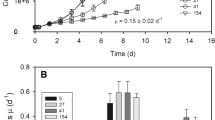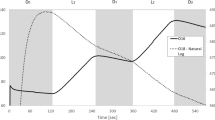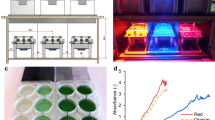Abstract
The yield of photosynthetic O2 evolution was measured in cultures of Dunaliella C9AA over a range of light intensities, and a range of low temperatures at constant light intensity. Changes in the rate of charge separation at Photosystem I (PS I) and Photosystem II (PS II) were estimated by the parameters ΦPS I and ΦPS II . ΦPS I is calculated on the basis of the proportion of centres in the correct redox state for charge separation to occur, as measured spectrophotometrically. ΦPS II is calculated using chlorophyll fluorescence to estimate the proportion of centres in the correct redox state, and also to estimate limitations in excitation delivery to reaction centres. With both increasing light intensity and decreasing temperature it was found that O2 evolution decreased more than predicted by either ΦPS I or ΦPS II. The results are interpreted as evidence of non-assimilatory electron flow; either linear whole chain, or cyclic around each photosystem.
Similar content being viewed by others
Abbreviations
- F0 :
-
dark level of chlorophyll fluorescence yield (PS II centres ‘open’)
- Fm :
-
maximum level of chlorophyll fluorescence yield (PS II centres ‘closed’)
- Fv :
-
variable fluorescence (Fm-F0)
- PS I:
-
Photosystem I
- PS II:
-
Photosystem II
- P700 :
-
reaction centre chlorophyll(s) of PS I
- qN :
-
coefficient of non-photochemical quenching of chlorophyll fluorescence
- qP :
-
coefficient of photochemical quenching of fluorescence yield
- qE :
-
high-energy-state quenching coefficient
- ΦPS I :
-
yield of PS I
- ΦPS II :
-
yield of PS II
- ΦS :
-
yield of photosynthetic O2 evolution
- ΦP :
-
intrinsic yield of ‘open’ PS II centres
References
AsadaK and BadgerMR (1984) Photoreduction of 18O2 and H2 18O2 with a concomitant evolution of 16O2 in intact spinach chloroplasts. Evidence for scavenging of hydrogen peroxide by peroxidase. Plant Cell Physiol 25: 1169–1179
AsadaK and TakahashiM (1987) Production and scavenging of active oxygen in photosynthesis. In: KyleDJ, OsmondCB and ArntzenCJ (eds) Photoinhibition, pp 227–287. Elsevier, Amsterdam
AsadaK, NeubauerC, HeberU and SchreiberU (1990) Methyl viologen-dependent cyclic electron transport in spinach chloroplasts in the absence of oxygen. Plant Cell Physiol 31: 557–564
Ben-HayyimG (1974) Light-induced absorbance changes of the high-potential cytochrome b 559 in chloroplasts. Eur J Biochem 41: 191–196
BilgerW and SchreiberU (1986) Energy-dependent quenching of dark level chlorophyll fluorescence in intact leaves. Photosynth Res 10: 303–308
BriantaisJM, VernotteC, PicaudM and KrauseGH (1979) A quantitative study of the slow decline of chlorophyll a fluorescence in isolated chloroplasts. Biochim Biophys Acta 548: 128–138
BriantaisJ-M, VernotteC, PicaudM and KrauseGH (1980) Chlorophyll fluorescence as a probe for the determination of the photo-induced proton gradient in isolated chloroplasts. Biochim Biophys Acta 591: 198–202
CramerWA and BohmeH (1972) High-potential cytochrome b 559 as a secondary quencher of chloroplast fluorescence in the presence of 3-(3,4-dichlorophenyl)-1,1-dimethylurea. Biochim Biophys Acta 256: 358–369
Demmig-AdamsB (1990) Carotenoids and photoprotection in plants: A role for the xanthophyll zeaxanthin. Biochim Biophys Acta 1020: 1–24
GentyB, BriantaisJ-M and BakerNR (1989) The relationship between quantum yield of photosynthetic electron transport and quenching of chlorophyll fluorescence. Biochim Biophys Acta 990: 87–92
GentyB, HarbinsonJ, BriantaisJ-M and BakerNR (1990) The relationship between the relative quantum efficiencies of photosystems in leaves. Efficiency of PS II in relation to non-photochemical quenching. In: BaltscheffskyM (ed) Current Research on Photosynthesis, Vol IV, pp 365–368. Kluwer Academic Publishers, Dordrecht, Boston, London
GinzburgM and GinzburgBZ (1981) Interrelationships of light, temperature, sodium chloride and carbon source in growth of halotolerant and halophilic strains of Dunaliella. British Phycol J 16: 313–324
HajibagheriMA, GilmourDJ, CollinsJC and FlowersTJ (1986) X-ray microanalysis and ultrastructural studies of cell compartments of Dunaliella parva. J Exp Bot 37: 1725–1732
HarbinsonJ and WoodwardFI (1987) The use of light-induced absorbance changes at 820 nm to monitor the oxidation state of P-700 in leaves. Plant Cell Environ 10: 131–140
HarbinsonJ, GentyB and BakerNR (1989) Relationship between the quantum efficiencies of Photosystems I and II in pea leaves. Plant Physiol 90: 1029–1034
HarbinsonJ, GentyB and BakerNR (1990) The relationship between CO2 assimilation and electron transport in leaves. Photosynth Res 25: 213–224
HeberU, KirkMR and BoardmanNK (1979) Photoreactions of cytochrome b 559 and cyclic electron flow in Photosystem II of intact chloroplasts. Biochim Biophys Acta 546: 292–306
HortonP and HagueA (1988) Studies on the induction of chlorophyll fluorescence in isolated barley protoplasts. IV. Resolution of non-photochemical quenching. Biochim Biophys Acta 932: 107–115
KrauseGH, VernotteC and BriantaisJ-M (1982) Photo-induced quenching of chlorophyll fluorescence in intact chloroplasts and algae. Resolution into two components. Biochim Biophys Acta 679: 116–124
LabateCA, AdcockMD and leegoodRC (1991) Effects of temperature on the regulation of photosynthetic carbon assimilation in leaves of maize and barley. Planta 181: 547–554
LeeCB, ReesD and HortonP (1990) Non-photochemical quenching of chlorophyll fluorescence in the green alga Dunaliella. Photosynth Res 24: 167–173
MehlerAH (1951) Studies on the reaction of illuminated chloroplasts. II. Stimulation and inhibition of the reaction with molecular oxygen. Arch Biochem Biophys 34: 339–351
OsmondCB (1981) Photorespiration and photoinhibition. Some implications for the energetics of photosynthesis. Biochim Biophys Acta 639: 77–98
OxboroughK and HortonP (1988) A study of the regulation and function of energy-dependent quenching in pea chloroplasts. Biochim Biophys Acta 934: 135–143
PetersFALJ, Van SpanningR and KraayenhofR (1983) Studies on well coupled Photosystem I-enriched subchloroplast vesicles. Optimization of ferredoxin-mediated cyclic photophosphorylation and electric potential generation. Biochim Biophys Acta 724: 159–165
PetersonRB, SivakMN and WalkerDA (1988) Relationship between steady-state fluorescence yield and photosynthetic efficiency in spinach leaf tissue. Plant Physiol 88: 158–163
QuickWP and HortonP (1984) Studies on the induction of chlorophyll fluorescence in barley protoplasts. I. Factors affecting the observation of oscillations in the yield of chlorophyll fluorescence and the rate of oxygen evolution. Proc R Soc Lond B 220: 361–370
QuickWP and StittM (1989) An examination of factors contributing to non-photochemical quenching of fluorescence in barley leaves. Biochim Biophys Acta 977: 287–296
RadmerR and KokB (1976) Photoreduction of O2 primes and replaces CO2 assimilation. Plant Physiol 58: 336–340
Radmer R and Ollinger O (1981) Fluorescence and gas exchange in Scenedesmus. Proc 5th Int Congr Photosynth 667–675
RadmerR, KokB and OllingerO (1978) Kinetics and apparent Km of oxygen cycle under conditions of limiting carbon dioxide fixation. Plant Physiol 61: 915–917
ReesD and HortonP (1990) The mechanisms of changes in Photosystem II efficiency in spinach thylakoids. Biochim Biophys Acta 1016: 219–227
ReesD, NoctorGD and HortonP (1990) The effect of high-energy-state excitation quenching on maximum and dark level chlorophyll fluorescence yield. Photosynth Res 25: 199–211
SchreiberU and NeubauerC (1987) The polyphasic rise of chlorophyll fluorescence upon onset of strong continuous illumination: II. Partial control by the Photosystem II donor side and possible ways of interpretation. Z Naturforsch 42c: 1255–1264
SchreiberU and NeubauerC (1990) O2-dependent electron flow, membrane energization and the mechanism of non-photochemical quenching of chlorophyll fluorescence. Photosynth Res 25: 279–293
SchreiberU and RienitsKG (1987) ATP-induced photochemical quenching of variable chlorophyll fluorescence. FEBS Lett 211: 99–104
SchrieberU, KlughammerC and NeubauerC (1988) Measuring P700 absorbance changes around 830 nm with a new type of pulse modulation system. Z Naturforsch 43c: 686–698
SeatonGGR and WalkerDA (1990) Chlorophyll fluorescence as a measure of photosynthetic carbon assimilation. Proc Roy Soc B 242: 29–35
SharkeyTD, BerryJA and SageRF (1988) Regulation of photosynthetic electron-transport in Phaseolus vulgaris L. as determined by room-temperature chlorophyll a fluorescence. Planta 176: 415–424
SlovacekRE, CrowtherD and HindG (1979) Cytochrome function in the cyclic electron transport pathway of chloroplasts. Biochim Biophys Acta 547: 138–148
WaltersRG and HortonP (1991) Resolution of components of non-photochemical chlorophyll fluorescence quenching in barley leaves. Photosynth Res 27: 121–134
WeisE and BerryJA (1987) Quantum efficiency if PS II in relation to ‘energy’ dependent quenching of chlorophyll fluorescence. Biochim Biophys Acta 894: 198–208
WeisE and LecthenbergD (1989) Fluorescence analysis during steady state photosynthesis. Phil Trans R Soc Lond B 323: 253–268
WeisE, BallJT and BerryJ (1987) Photosynthetic control of electron transport in leaves of Phaseolus vulgaris: evidence for regulation of PS II by the proton gradient. Proceedings VIIth International Congress on Photosynthesis, BigginsJ (ed) Vol 2, pp 553–556. Martinus Nijhoff, Dordrecht
Author information
Authors and Affiliations
Rights and permissions
About this article
Cite this article
Rees, D., Lee, C.B., Gilmour, D.J. et al. Mechanisms for controlling balance between light input and utilisation in the salt tolerant alga Dunaliella C9AA . Photosynth Res 32, 181–191 (1992). https://doi.org/10.1007/BF00034794
Received:
Accepted:
Issue Date:
DOI: https://doi.org/10.1007/BF00034794




